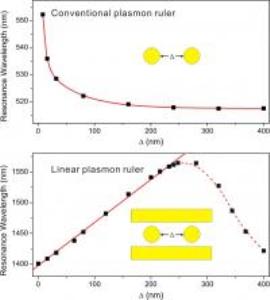Sep 3 2010
With the advent of nanometer-sized machines, there is considerable demand for stable, precise tools to measure absolute distances and distance changes. One way to do this is with a plasmon ruler. In physics jargon, a "plasmon" is the quasiparticle resulting from the quantization of plasma oscillation; it's essentially the collective oscillations of the free electron gas at a metallic surface, often at optical frequencies.
A noble metallic dimer (a molecule that results from combining two entities of the same species) has been used as a plasmon ruler to make absolute distance and distance change measurements.
 In contrast to a conventional nanoparticle dimer plasmon ruler, this new one shows an approximately linear relationship between the resonance wavelength shifts and nanosphere dimer interparticle separation for a linear plasmon ruler.
In contrast to a conventional nanoparticle dimer plasmon ruler, this new one shows an approximately linear relationship between the resonance wavelength shifts and nanosphere dimer interparticle separation for a linear plasmon ruler.
Physicists at China's Wuhan University discovered that nanospheres combined with a nanorod dimer could be used to solve the problem of measurement sensitivity. They provide details about their findings in the American Institute of Physics' Journal of Applied Physics.
Shao-Ding Liu and Mu-Tian Cheng used a nanostructure as a linear plasmon ruler. Nanospheres were used to modify surface plasmon coupling of a nanorod dimer. They found that the resonance wavelength shift increases approximately linearly with the increasing of a nanosphere's interparticle separations -- resulting in a structure that's useful as a plasmon ruler with homogenous measurement sensitivity.
"A nanoparticle dimer plasmon ruler possesses many advantages because its measurement sensitivity is homogeneous, it can operate in the near-infrared region, and the structure's size and nanorod aspect ratio can be modified freely to get the desired measurement range and sensitivity," notes Liu.
Applications for the linear plasmon ruler extend beyond studies of optical properties of metallic nanostructures to single-molecule microscopy, surface-enhanced Raman spectroscopy, waveguiding and biosensing.